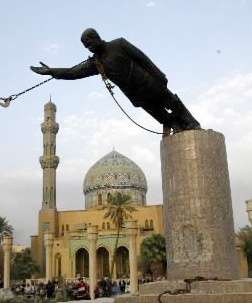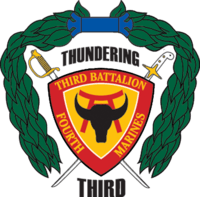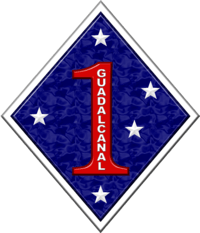3rd Battalion 4th Marines
| 3rd Battalion, 4th Marines | |
|---|---|
|
3/4 insignia | |
| Active |
|
| Country | United States |
| Allegiance | United States |
| Branch | United States Marine Corps |
| Type | U.S. Marine Corps Infantry Battalion |
| Part of |
7th Marine Regiment 1st Marine Division |
| Garrison/HQ | Marine Corps Air Ground Combat Center Twentynine Palms |
| Nickname(s) |
Thundering Third The Bull DARKSIDE |
| Mascot(s) | The water buffalo of Southeast Asia |
| Engagements |
World War II * Battle of Corregidor * Battle of Bougainville * Battle of Guam * Battle of Okinawa Vietnam War * Operation Hastings * Operation Prairie * Operation Hickory * Operation Kingfisher * Operation Kentucky Operation Iraqi Freedom * Operation Vigilant Resolve Operation Enduring Freedom |
| Commanders | |
| Notable commanders | General Robert Neller |
3rd Battalion, 4th Marines (3/4) is an infantry battalion of the United States Marine Corps. Nicknamed "Thundering Third". The most recent leader Lt. Col. B.P. Mccoy's radio callsign is "Darkside". They are based at the Marine Corps Air Ground Combat Center, Twentynine Palms, California, and consist of approximately 1,000 Marines. The unit currently falls under the command of the 7th Marine Regiment, 1st Marine Division, but — along with its two sister battalions — is hosted by the 3rd Marine Division, at Camp Schwab in Okinawa, Japan, when training in jungle warfare. The 3rd falls under the 4th Marine Regiment at such times.
Subordinate units
- Headquarters and Service Company
- Company I (India Company)
- Company K (Kilo Company)
- Company L (Lima Company)
- Company M (Mike Company - not currently in use; company designation reserved for augmentation of a fourth rifle company into the battalion as needed)
- Weapons Company
History
Early Years
The battalion was first activated in 1925 at Naval Base San Diego, California. Since its initial inception in 1925, this unit has had several periods of activation.
World War II
On May 1, 1941 at Cavite, Philippine Islands became the First Separate Marine Battalion, Navy Yard, Cavite. Relocated during December 1941 to Corregidor, Philippine Islands. Redesignated January 1, 1942 to the Third Battalion, Fourth Marines, Corregidor, Philippine Island. The 4th Marine Regiment participated in the Battle of Corregidor from January to May 1942. The unit was surrendered by an Army General and subsequently captured by enemy forces on May 6, 1942. After this 4th Marines temporarily ceased to exist.
The regrouped 3rd Battalion 4th Marines of the 3rd Marine Division, participated in the Battle of Iwo Jima reinforcing the other Marine units of the 4th and 5th Marine Divisions already there fighting. The 3rd Marine Division and other Marine Divisions were regrouping and training for the invasion of Japan, but before they were sent there, the Atomic Bomb was dropped on Hiroshima and Nagasaki finally bringing World War II to an end.
Vietnam War
On April 14, 1965 3rd battalion 4th Marines was deployed to an area near Chu Lai, South Vietnam. Two companies were sent north to Phu Bai to secure a small airfield just 8 miles south of Huế City. First contact was made on April 22 southwest of Da Nang with a VC unit. The Marines at Phu Bai made their first contact on April 24. Both sides lost 2 men. These patrols continued until the whole battalion re-deployed back to Okinawa on December 24, 1965. In March 1966, the Battalion returned to the Phu Bai, Huế City areas. They participated in company and platoon size patrols and ambushes against the VC in the Thừa Thiên–Huế Province till the end of June 1966. At that time the entire Battalion moved north and just south of the DMZ, in the Song Ngan River Valley also known as "Helicopter Valley", because of all the helicopters that were shot down with Marines on board. There they participated in Operation Hastings which was a multi-battalion operation that ran from July 15 to August 3, 1966. This was the first major Marine campaign against the North Vietnamese Army. A total of 8,000 Marines participated in this large operation. It stop the NVA from further advancing into South Vietnam. The 324B NVA Division losses were put at 824 killed and 17 POW's. Total Marine losses were put at 126 killed and 448 wounded. Capt. Robert J. Modrzejewski and SSgt. John J. McGinty were both awarded the Medal of Honor for their action and leadership during this time. This operation was also the most costly of the war to this point.

In August 3/4 was back in Phu Bai again running patrols and ambushes in search and destroy missions. Early September the battalion moved its HQ 55 miles north to Đông Hà. On September 22, 1966 the battalion was again in action against the 324B NVA Division in Operation Prairie which ran from August 3 to October 27, 1966. Fighting for Hill 400 and Hill 484 and also called Mutter's Ridge in the Razor Back Mountains, a heavily fortified Nui Cay Tri ridge. It was very costly for both sides, losses were put at nearly 1300 NVA killed and total Marine losses were put at 200 killed and over a 1000 wounded. Captain James J. Carroll was later posthumously awarded a Navy Cross for valor on Hill 484.
Photojournalist Larry Burrows took a large collection of Time-Life photos during the operation. The most recognizable is a Pulitzer Prize winning photo, taken on Hill 400, showing a wounded Gunnery Sergeant Jeremiah Purdie being guided by a Hospital Corpsman Darrell Hinde as he reaches out to Sergeant [Larry Mitchel] whom was also seriously wounded waiting to be medevaced. Photo is called "Reaching Out" Shown in many special Time-Life issues.
At the end of 1966 the 4th Marine Regiment was pulled out of the DMZ and sent south to participate in Operation Chinook around Huế. When that operation ended the battalion went into a rebuilding stage.
On January 31, 1967 Operation Prairie II started. On February 27 L/3/4 and a tank platoon was involved in a battle near Hill 48 to save a recon team that ran into a NVA Regiment. On the 28th other Marine companies including M/3/4 were brought in for ground operation. When the operation ended total casualties for both sides were put at 93 Marines killed 483 wounded and the NVA losses were put at 694 killed. Prairie II ended on March 18, but Operation Prairie III started the next day. The battalion was pulled back to regroup and rebuild. For the next couple of months the battalion worked Route 9 guarding lines near Cam Lo, The Rockpile and Camp Carroll, which was the largest concentration of artillery pieces in northern I Corp. July and parts of August it was time for the battalion to spend time in the "Barrel", Con Thien. On September 4 the Battalion was ambushed just south of Con Thien with heavy casualties. 3/4 was pulled back for rebuilding its manpower. Some of the other major Operations in 1967 were Operation Hickory (May 18 to May 28), Operation Kingfisher (July 16 to Oct 31) and Operation Kentucky near Con Thien in the western area of Leatherneck Square in the latter part of 1967 and in January 1968. The new battalion CO LtCol Frank L. Bourne, Jr. took over command. Other operations the Battalion participate in 1968 and 1969 were Operation Lancaster II (Jan 21 to Nov 25, 1968), and Operation Robin (2–19 June) along Route 9 southeast of Khe Sanh.
After November 6, 3/4 was the last infantry battalion of the 3rd Marine Division left in South Vietnam. On November 24, 1969 the battalion sailed from Vietnam to Okinawa.
1980s & 1990s
The first Marine unit in combat in Panama during Operation Just Cause was India Company, 3/4. They landed in Panama on April 6, 1988 and by April 10 were engaged in combat with clandestine units from Cuba. Some might have been from the 7th Company of the Panamanian Defense Forces, known as the "Macho de Monte" or "mountain machos", a special ops / guerrilla warfare unit named after a sort of aggressive wild boar.
1996–1997 saw the battalion participate in Operation Hunter Warrior (Sea Dragon). The objective of the operation was to test experimental gear, weapons and other equipment essential to a Marine Rifle Squad. In 1998 the battalion was transferred from Camp Pendleton, California to Marine Corps Air Ground Combat Center in 29 Palms, California. There they worked back to full battalion strength and prepared for deployment to Camp Schwab, Okinawa in 1999–2000.
During this time the battalion also completed the summer and winter warfare training packages at Marine Corp Cold Weather Training Bridgeport,Ca.
Global War on Terrorism - Iraq


3/4 deployed to Kuwait in January 2003 and went on to participate in the 2003 invasion of Iraq. The group was led by Lt. Col. Brian P. McCoy. They were the first U.S. Marine unit to enter Baghdad. This battalion was shown in the famous scene of the statue of Saddam in Firdos Square being pulled down. The battalion redeployed to Iraq in March 2004 and subsequently took part in Operation Vigilant Resolve while attached to the 1st Marine Regiment. They subsequently deployed to Fallujah, Iraq in January 2005 and provided oversight for Iraq's first national election in decades. 3/4 deployed again in September 2006 to the Al Qaim region in the Euphrates River Valley of Iraq, in Western Al Anbar Province, conducting counter insurgency combat operations and support and security operations. 3/4 saw heavy fighting throughout the deployment. The Marines were spread out in individual platoon-sized combat outposts along the river side, where fighting was especially intense, particularly in the first half of their extended 9 month deployment. Around Spring time in the second half of the Marines' deployment, the fighting turned to more small scale ambushes and IED attacks conducted by the enemy, who had become increasingly affected by losses in manpower and equipment in the large scale fighting that took place throughout the Fall and Winter months of 2006 and 2007. The battalion suffered 12 KIA, and over 100 WIA during the nearly 9 month deployment, which was due to being extended for the Troop Surge in early 2007. After returning home to Twentynine Palms in late May, 2007, the battalion again deployed in early 2008 to Al Anbar with dual missions of carrying out combat operations, training Iraqi security forces, and supervising the Iraqi peacekeeping effort. Their area of operations reached from Haditha to Hit, becoming the largest area any military unit had controlled in support of Operation Iraqi Freedom. The battalion also became the first U.S. military unit to reach 5 straight Iraq deployments and returned from their deployment in early September 2008. They are also one of only two Marine battalions with eight straight combat deployments, the other being 3/7.[1][2]
Global War on Terrorism - Afghanistan
The battalion deployed in support of Operation Enduring Freedom in Afghanistan from October 2009 to May 2010, April to October 2011 and from March to September 2013.
3/4 Medal of Honor recipients
Notable Personnel
See also
| Wikimedia Commons has media related to 3rd Battalion 4th Marines. |
- Operation Vigilant Resolve
- Organization of the United States Marine Corps
- List of United States Marine Corps battalions
Notes
- ↑ Koopman, John (September 3, 2006). "Marine battalion heads to Iraq for fourth time / Tears flow as loved ones bid goodbye to unit members in Twentynine Palms". The San Francisco Chronicle. Retrieved 2006-09-21.
- ↑ "3/4, CLB-7 return first hundred service members". Archived from the original on September 16, 2008. Retrieved 2015-12-15.
References
![]() This article incorporates public domain material from websites or documents of the United States Marine Corps.
This article incorporates public domain material from websites or documents of the United States Marine Corps.
- Bibliography
- Condit, Kenneth W.; Turnbladh, Edwin T. (1960). Hold High the Torch - A History of the 4th Marines. Washington, D.C.: Historical Branch, Headquarters Marine Corps.
- Web
- 3/4's official website
- Koopman, John (September 3, 2006). "Marine battalion heads to Iraq for fourth time. Tears flow as loved ones bid goodbye to unit members in Twentynine Palms". SFGate.com. Retrieved 2006-09-21.
- U.S. Marines launch major Afghan offensive


